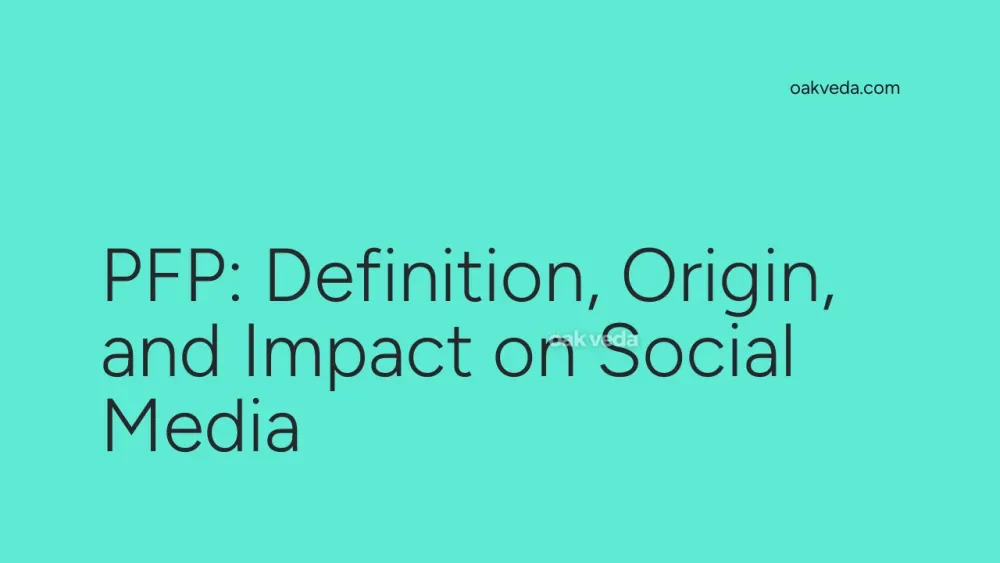
What is PFP?
PFP is an acronym that stands for "Profile Picture" in the context of social media and online platforms. It refers to the image or avatar that represents a user on their social media accounts, forums, or other digital spaces. Your PFP is often the first visual element people see when they interact with your online presence, making it a crucial component of your digital identity.
Origin and Development of PFP
The concept of a profile picture has been around since the early days of social media and online forums. However, the abbreviation "PFP" gained popularity in the late 2000s and early 2010s as social media platforms became more prevalent. The term emerged as a shorthand way to discuss and refer to profile pictures in online conversations, particularly among younger internet users.
How PFP Works
A PFP functions as a visual representation of a user across various online platforms. When you create an account on a social media site or forum, you're typically prompted to upload an image that will serve as your profile picture. This image is then displayed alongside your username or handle in various contexts, such as:
- Next to your posts or comments
- In search results
- On your profile page
- In direct message conversations
- In friend lists or follower/following sections
Types or Variations of PFP
While PFP generally refers to profile pictures, there are several types and variations users might choose:
- Selfies: Personal photos of the user, often showing their face
- Avatars: Digital illustrations or cartoon representations of the user
- Logos: For business accounts or personal branding
- Memes or Pop Culture References: Images that reflect the user's interests or sense of humor
- Artwork: Original or curated art pieces
- Nature or Landscape Photos: Scenic images that resonate with the user
- Pets: Photos of beloved animals
Popular Examples of PFP
Some notable examples of PFP trends include:
- NFT Profile Pictures: In 2021-2022, many users adopted NFT (Non-Fungible Token) artwork as their PFPs, particularly on Twitter.
- Causes and Movements: Users often change their PFPs to support social causes, such as adding filters for pride month or black squares for racial justice.
- Fandom PFPs: Fans of movies, TV shows, or music artists often use images of their favorite characters or celebrities.
Impact of PFP on Social Media Culture
The PFP has become a significant aspect of online culture, influencing how users perceive and interact with each other. Some key impacts include:
- First Impressions: A PFP often forms the basis of a user's first impression, potentially affecting how others perceive and engage with them.
- Personal Branding: Users carefully select PFPs to convey their personality, interests, or professional image.
- Community Identification: PFPs can signify membership or affiliation with certain online communities or fandoms.
- Visual Communication: In an increasingly visual online world, PFPs serve as a quick, non-verbal form of self-expression.
Controversies or Debates Surrounding PFP
While PFPs are generally straightforward, they've been at the center of some debates:
- Privacy Concerns: Some users opt for non-personal images to protect their privacy online.
- Catfishing: The use of misleading or fake PFPs to deceive others has led to trust issues in online interactions.
- Platform Policies: Social media sites often have guidelines about appropriate PFP content, leading to debates about censorship and freedom of expression.
How Brands and Influencers Use PFP
For brands and influencers, a PFP is a crucial element of their online presence:
- Brand Recognition: Companies use logos or consistent imagery as PFPs to reinforce brand identity.
- Influencer Marketing: Influencers often carefully curate their PFPs to align with their personal brand and appeal to their audience.
- Campaign Integration: Brands sometimes encourage users to change their PFPs as part of marketing campaigns or to show support for causes.
Future Trends Related to PFP
As social media continues to evolve, so too will the role and nature of PFPs:
- Animated PFPs: Some platforms are beginning to support GIFs or short video loops as profile pictures.
- AR Integration: Augmented reality features may allow for more interactive or dynamic PFPs.
- AI-Generated PFPs: As AI art becomes more sophisticated, we may see an increase in AI-created profile pictures.
- Cross-Platform PFPs: There may be a push for unified PFPs across different social media platforms for consistent personal branding.
FAQs about PFP
-
How often should I change my PFP? There's no set rule, but updating your PFP occasionally can keep your profile fresh and reflect your current self or interests.
-
Can a PFP affect my social media engagement? Yes, an attractive or intriguing PFP can potentially increase profile visits and engagement.
-
Are there any restrictions on what I can use as a PFP? Most platforms have guidelines prohibiting offensive content, copyrighted material without permission, or impersonation.
-
Should my PFP be the same across all social media platforms? While not necessary, using consistent PFPs can help with personal branding and make you easily recognizable across platforms.
-
Can I use a logo as my personal PFP? Yes, especially if you're building a personal brand or representing a business.
In conclusion, while PFP might seem like a simple concept, it plays a significant role in shaping online identities and interactions. As the digital landscape continues to evolve, the importance of choosing the right profile picture remains a key aspect of managing one's online presence.
You may be interested in:
- Open Graph: Definition, Origin, and Impact on Social Media
- User-Generated Content (UGC): Definition, Origin, and Impact
- Simp: Definition, Origin, and Impact on Social Media
- Influencer: Definition, Origin, and Impact on Social Media
- Soft-Launch: Definition, Origin, and Impact on Social Media
- Engagement Rate: Definition, Origin, and Impact

